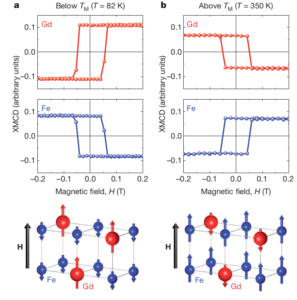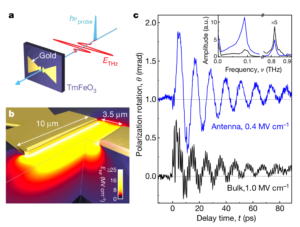Project involvement
Advanced spectroscopy of complex magnetism
Optical sensing and control of topologically protected states
Coherent phono-magnetism: static and dynamical manipulation of magnetism via lattice degrees of freedom
Publications in QuMat
| Coherent THz spin dynamics in antiferromagnets beyond the approximation of the Néel vector F. Formisano, T. T. Gareev, D. I. Khusyainov, A. E. Fedianin, R. M. Dubrovin, P. P. Syrnikov, D. Afanasiev, R. V. Pisarev, A. M. Kalashnikova, J. H. Mentink, A. V. Kimel APL Mater. 1 121, 1 011105 (2024) |
| Canted spin order as a platform for ultrafast conversion of magnons R.A. Leenders and D. Afanasiev and A.V. Kimel and R.V. Mikhaylovskiy Nature (2024) |
| Two-Dimensional Terahertz Spectroscopy of Nonlinear Phononics in the Topological Insulator MnBi2Te4 T.G.H. Blank and K.A. Grishunin and K.A. Zvezdin and N.T. Hai and J.C. Wu and S.-H. Su and J.-C.A. Huang and A.K. Zvezdin and A.V. Kimel Physical Review Letters 131, 26902 (2023) |
| Ultrafast laser-induced spin-lattice dynamics in the van der Waals antiferromagnet CoPS3 D. Khusyainov and T. Gareev and V. Radovskaia and K. Sampathkumar and S. Acharya and M. Šiškins and S. Mañas-Valero and B.A. Ivanov and E. Coronado and Th. Rasing and A.V. Kimel and D. Afanasiev APL Materials 11, 7 071104 (2023) |
Brief research summary over last 5 years / academic profile
The Kimel group explores magnetization dynamics in an ultrafast regime in which thermodynamic theories fail and modeling requires developing new approximations. These studies allowed the group to achieve several breakthroughs in the area of femtosecond magnetism, which may impact future technologies for ultrafast magnetic recording, THz spintronics and THz magnonics.
The group continuously develops novel experimental approaches and its unique experimental setups, including femtosecond imaging, pumping in a broad spectral range (from THz to visible) and time-resolved measurements in high magnetic fields, allow it to keep its leading position in the field of ultrafast magnetism.
Using single-shot femtosecond imaging, the Kimel team discovered novel routes for heat-assisted magnetic recording (PRL 2019), demonstrated so far the fastest and least dissipative magnetic recording ever (Nature 2017) and revealed the selection rules for ultrafast magnetic recording that does not require external magnetic fields or heat (Nature Comm 2019). Using sub-10 fs laser pulses and the mechanism for optical control of the exchange interaction (Nature Comm 2015), they succeeded to excite, control and detect presumably entangled magnons with nanometer wavelengths in fluoride antiferromagnets (Nature Comm 2016, PRB2019). Using THz emission spectroscopy, they demonstrated that femtosecond circularly polarized laser pulses can efficiently generate and control femtosecond photocurrent pulses at interfaces of spintronic multilayers (Nature Nano 2016).
At the High Field Magnet Laboratory (HFML), Kimel’s group built a unique setup to study ultrafast processes in fields up to 38 Tesla. They discovered and explained anomalies in ultrafast and static magnetism in technologically relevant rare-earth transition metal alloys in high magnetic fields (PRL 2017, PRB 2019). In recent years, Kimel develops methods for ultrafast control of magnets with the help of intense, nearly single-cycle pulses of THz radiation. The idea of this is to develop materials that allow for THz magnetic recording with dissipations as low as the Landauer limit, in line with the overall mission of this program. This led to the discovery of new mechanisms for efficient control of magnetism with the help of THz pulses (Nature Physics 2016, Nature 2019).
International visibility, activities, prizes, scholarships etc.
With an NWO Veni-fellowship (2004), Kimel started his independent research group under the umbrella of Prof. Theo Rasing. He confirmed his independence by obtaining an NWO Vidi grant in 2006 on ultrafast opto-magnetism. In 2006 he was appointed Assistant Professor at Radboud University. In 2007 he initiated two European networks (NMP UltraMagnetron and ITN Fantomas) to develop the fastest ever magnetic recording at the nanoscale. The networks comprised more than 15 partners, including two synchrotrons (SLS – Switzerland; Bessy – Germany) and companies (Seagate and NXP). In these networks he acted as the daily manager (2008-2012). In 2010 he won an ERC Starting Grant which allowed him to become one of the leaders in the field of ultrafast magnetism. In 2013 he became Associate Professor at Radboud University. Via a prestigious Russian MegaGrant he was the leading scientist in the project on Dynamics in Ferroics in Moscow in the period 2014-2019. In 2017, Kimel won an NWO Vici grant and was appointed as full professor at Radboud University. In 2019 he received his habilitation in Russia and was also elected as a Distinguished Scientist in CAS President’s International Fellowship Initiative in China. His work on ultrafast magnetism was nominated by Kijk magazine for the best High-tech idea 2019.
Kimel is often invited as a speaker at universities, international conferences and schools (8 accepted invitations per year). For instance, he was invited to participate in a conclave organized by Seagate to discuss the future of magnetic recording. He was invited to a closed workshop organized by the US department of energy to discuss the problems of magnetism at interfaces and write a review for Review of Modern Physics on this topic. He was a plenary speaker at international conferences such as MISM and Eastmag. He is also active in program committees (member, vice-chair, co-chair) of several regular international conferences (Spin Waves, MORIS, Ultrafast Magnetism, MISM, ICM).
Kimel is recognized as an expert in fields of condensed matter spectroscopy in a broad spectral range. He is a member of the Scientific Advisory Board at FELBE (Helmholtz Centrum Dresden-Rossendorf), member of Proposal Review Panels at FERMI (Elettra Syncrotrone Trieste), and the European XFEL in Hamburg, member of the panel for grants of the Government of the Russian Federation and guest professor at the Hefei Institutes of Physical Science (Chinese High Magnetic Field Laboratory, Chinese Academy of Sciences). His network includes more than 30 groups from over 10 countries including Russia, Ukraine, China, Japan and the USA. He collaborates with international companies (Seagate, Western Digital, SKF, NXP, ASM Pacific, NT-MDT Europe BV, Hitachi). He has initiated and coordinates a large European ITN program COMRAD to develop Cold Opto-magnetism for Random Access Devices.
5 key output/publications
Laser-induced ultrafast spin reorientation in the antiferromagnet TmFeO3.
A.V. Kimel, A. Kirilyuk, A.A. Tsvetkov, R.V. Pisarev and T. Rasing, Nature 49, 850 (2004).
The very first experimental demonstration of ultrafast (sub-10 ps) spin-reorientation in antiferromagnets. This work revealed unique functionalities of antiferromagnets and became one of the motivations for the presently very hot topic of antiferromagnetic spintronics.
Ultrafast non-thermal control of magnetization by instantaneous photomagnetic pulse.
A.V. Kimel, A. Kirilyuk, P.A. Usachev, R.V. Pisarev, A.M. Balbashov, and T. Rasing, Nature 435, 655 (2005).
Discovery of ultrafast inverse Faraday effect in magnetic material (DyFeO3). This work showed the possibility for ultrafast control of magnetism and eventually magnetic recording with the help of circularly polarized light.
Transient ferromagnetic-like state mediating ultrafast reversal of antiferromagnetically coupled spins. I. Radu, K. Vahaplar, C. Stamm, T. Kachel, N. Pontius, H.A. Durr, T.A. Ostler, J. Barker, R.F.L. Evans, R.W. Chantrell, A. Tsukamoto, A. Itoh, A. Kirilyuk, T. Rasing, and A.V. Kimel, Nature 472, 205-208 (2011).
I. Radu, K. Vahaplar, C. Stamm, T. Kachel, N. Pontius, H.A. Durr, T.A. Ostler, J. Barker, R.F.L. Evans, R.W. Chantrell, A. Tsukamoto, A. Itoh, A. Kirilyuk, T. Rasing, and A.V. Kimel, Nature 472, 205-208 (2011).
Discovery of counter-intuitive behavior of a ferrimagnet after excitation with a femtosecond laser pulse. This work led to a revolution in the present understanding of optical control of magnetism. In particular, it helped to realize that heat not only destroys, but also can reverse magnetization.
Ultrafast nonthermal photo-magnetic recording in a transparent medium.
A. Stupakiewicz, K. Szerenos, D. Afanasiev, A. Kirilyuk, and A.V. Kimel, Nature 542 7639 (2017).
Discovery of the fastest and the least dissipative magnetic recording (1000 times faster and 5000000 times less dissipative than in hard drives).
Temporal and spectral fingerprints of ultrafast all-coherent spin switching. S. Schlauderer, C. Lange, S. Baierl, T. Ebnet, C.P. Schmid, D.C. Valovcin, A.K. Zvezdin, A.V. Kimel, R.V. Mikhaylovskiy, and R. Huber, Nature 569, 383 (2019).
S. Schlauderer, C. Lange, S. Baierl, T. Ebnet, C.P. Schmid, D.C. Valovcin, A.K. Zvezdin, A.V. Kimel, R.V. Mikhaylovskiy, and R. Huber, Nature 569, 383 (2019).
Although dissipationless recording at THz frequencies is still a science fiction, here we show what kind peculiarities in spectral and temporal domain such a recording would have.
